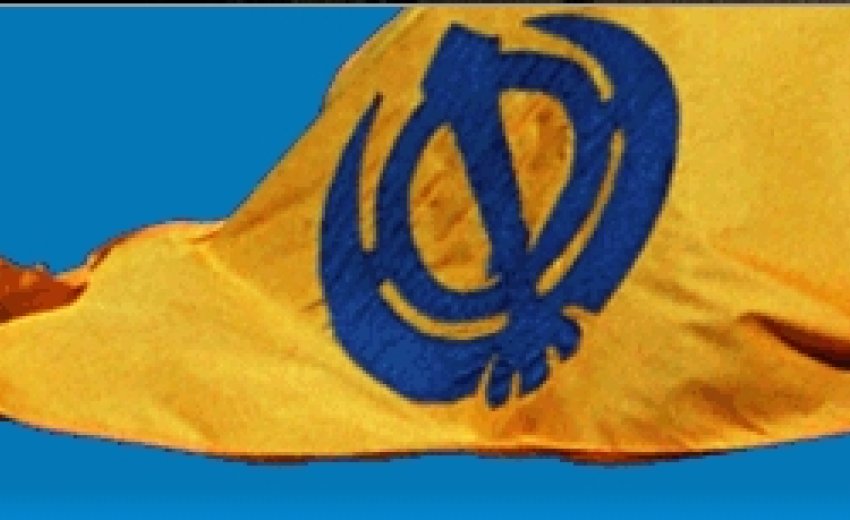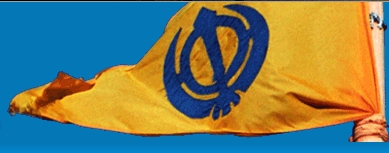 The position of the Nishan Sahib among the Sikhs is not only significant and
important but unique and unparalleled when compared to the other flags in the
the world. There has been little constructive discussion, and far less
constitutional understanding among the Sikhs regards the Nishan sahib and
its existence and the position in the Sikh faith. Many think it's
significance is simply as much as that of the flag of a country!
The position of the Nishan Sahib among the Sikhs is not only significant and
important but unique and unparalleled when compared to the other flags in the
the world. There has been little constructive discussion, and far less
constitutional understanding among the Sikhs regards the Nishan sahib and
its existence and the position in the Sikh faith. Many think it's
significance is simply as much as that of the flag of a country!
Let us explore this further and share understanding about the subject, development and origins of the Nishan Sahib, and it's history.
Unlike the flags of nations, the Nishan sahib is not simply a "flag" of the Sikhs. It is connected seriously to the Sikhs' developed tradition, Sikh image / vision, Sikh cultural and religio-spiritual history of its people and the community's futuristic aspirations.
The Nishan sahib is undoubtedly the 'living' ensign of the continual high spirited development of the Sikhs, it is the sign of the ever revolutionary Sikh religion and its hard working adherents. It is perhaps the only flag that was created for more than being a flag. Many may believe that it is the expression of our military and warrior tradition, might and a window of the fighting qualities of the martial Sikhs; and that it began with Guru Hargobind Sahib Ji, which is an incorrect assumption.
Guru Amardas Ji in the following shabad merited by a bhat called kalashar says-
Jis dhiraj dhor dhaval dhuja, sait bekunth binna. Sawaiye meh 3rd,1392/15
[ਜਿਸ ਧੀਰਜ ਢੋਰ ਧਵਲ ਧੁਜਾ , ਸਿਤ ਬੇਕੁੰਠ ਬਿੰਨਾ . ਸਵੈਯੇ ਮੇਹਲਾ ੩ਰ੍ਦ ,੧੩੯੨ /੧੫]
This shabad indicates that there was a white Flag that flew over the centre at Goindwal sahib. This suggests that prior to Guru Hargobind Sahib there was already the Nishan of PIRI- saintliness - in existence.
Some scholars of Sikhism are of the opinion that the mentioned white flag carried the sign of the 1(??
This flag is believed to represent Guru Nanak's Era [raj]- rule- as said in Ramkali Vaar, Rai Balwand, Ang 966/15
Nanak Raj Chalaiya
sach kott stani niv de//
funn Dharam dhuja farhat sda
aggh punj trangg nivawaran kau//
[ਨਾਨਕ ਰਾਜ ਚਲਾਯਾ ਸਚ ਕੋੱਟ ਸਤਾਣੀ ਨੀਵ ਦੇ // ਫੁੰਨ ਧਰਮ ਧੁਜਾ ਫਰੱਹਟ ਸਦਾ ਅਗ੍ਗ੍ਹ ਪੁੰਜ ਤ੍ਰਾਨੱਗ ਨਿਵਾਵਾਰਾਂ ਕੌੳ//]
sawaiye :4, Bhat Mathra Pages 1404/06.....
However, the colour appears to have changed from white to saffron. Further changes took place which we will discuss later on after the martydom of Guru Arajan Dev Ji.
In swaiye 5, kal, ang 1407/016 it says ...Dharam dhuja Arjan har Bhagta.....[ਧਰਮ ਧੂਜਾ ਅਰਜਨ ਹਰ ਭਗਤਾ ]
In the supplicatory prayers [ARDAS], it is read :-
Sikhaa Noo Sikhee Daan, Kesh Daan, Rehit Daan, Bibek Daan, Bharosaa Daan,
Daanaa Sir Daan Naam Daan, Chounkiyaa Jhande Bunge Jugo Jug Attal, Dharam Ka
Jai Kaar Bolo Ji Waheguroo
ਸਿਖਾਂ ਨੂੰ ਸਿਖੀ ਦਾਨ, ਕੇਸ਼ ਦਾਨ, ਰਹਿਤ ਦਾਨ, ਬਿਬੇਕ ਦਾਨ, ਭਰੋਸਾ ਦਾਨ,
ਦਾਨਾ ਸਿਰ ਦਾਨ ਨਾਮ ਦਾਨ, ਚੋਉਂਕਿਯਾਂ ਝੰਡੇ ਬੁੰਗੇ ਜੁਗੋ ਜੁਗ ਅੱਟਲ,
ਧਰਮ ਕਾ ਜੈ ਕਾਰ ਬੋਲੋ ਜੀ ਵਾਹਿਗੁਰੂ]
Kindly confer upon the Sikhs the gift of Sikhism, the gift of long (uncut) hair, the gift of observing Sikh laws, the gift of divine knowledge, the gift of firm faith, the gift of belief and the biggest gift of Name (Naam). O God! May the choirs, the mansion and the banners exist forever; may the truth ever triumph; utter Wahe Guru (Wondrous God)!
Thus, it can be seen there is a special mention and position of the Nishan Sahib in the most important part of Sikh prayers. Sikh history tells that Sikhs have fought bravely and attained martydom while defending the Nishan Sahib.
Just how important and privileged the Nishan Sahib is regarded by the Sikh Panth can be gauged from the following story of one Sikh, Bhai Alam Singh Ji.
It is said, Bhai Alam Singh Ji was captured by the Mughals during the second battle of Anandpur Sahib, as he advanced far forward than the Sikh positions, and continued to carry the fluttering Sikh Nishan Sahib proudly and without fear. He soon found himself surrounded by the enemy soldiers. The Mughal Commander ordered Alam Singh Ji to "throw the Nishan Sahib down ".Bhai Alam Singh Ji replied, "THIS Flag is the symbol of my personal dignity and that of my Guru and I will never let it fall".
The Mughal Commander then says "we will cut off your hands, in that case."
Bhai Alam Singh Ji without an iota of fear, replied, "In that case, I will carry the Nishan Sahib with my feet." The Mughal said, we will cut off your legs too.
Bhai Alam Singh Ji boldly defying, responded, "Then, I will hold it between my lips, with my mouth! This flag belongs to my GURU, I will never let it fall ever"
The commander retorted, 'we will blow your head off, what will you do then? 'Bhai Alam Singh Ji responded by saying "In that case, only HE, who owns & is the Master of this Nishan Sahib, will come himself in person to uphold it and the Khalsa Panth's dignity high! But while I breathe, I will hold it high".
In those days, the rules of war were that no flag carrier was ever killed or shot by the enemy, but the Mughal commander seeing such fierce and emboldened defiance from Bhai Alam Singh; with one swipe, cut off Bhai Alam Singh Ji's head, in clear violation of the agreed rules of engagement in battle.
But it is said that before the Nishan Sahib could fall to the ground, Guru Gobind Singh Ji's [son] Sahibzada, Baba Ajit Singh Ji appeared and took hold of the Nishan sahib and held the Nishan Sahib high with one hand, while with the other he slayed off the head of the Mughal Commander, spreading fear and chaos in the ranks of the enemy!
The Nishan sahib is a gift from the Guru ji. As it flies and flutters majestically high in the air, the Guru Ji 's entire message of Sikhism is shared over the Gurduara sahib and holds firmly, giving out its light of hope and truth of Naam, Jaap and Sewa as well as symbolising the victoriousGuru Khalsa. It also reflects the autonomous state of mind, spirit and physical independance of the Sikhs.
May it flutter forever, as the Sikhs live and prosper. Historians & experts of Punjabi language define the Nishan sahib as a triangular piece of cloth, [Far-lha], saffron in colour, hung on a spear or a high pole with a pointed khanda [double egded sword]; embeded into that triangular cloth is the Sikh emblem of Khanda [with a round chakra, with a double edged sword running in its middle with two kirpans on either side of the chakra]
It is a historically customary practice among Sikhs, that if a Nishan sahib is hoisted for the first time for a Gurduara, then it should be brought from a historically important shrine or spot. It is firmly believed it will fly forever and offer guidance and dignity and be part of the history of the Sikhs in time to come.
The Nishan sahib is triangular in shape, with both top opposing ends @ 45
degrees. It is embedded with an ![]() [EK'o'n] and the Khanda.
[EK'o'n] and the Khanda.
A number of historical records are associated with the Nishan Sahib. In one, Pracheen Panth Prakash, by Rattan Singh Bhangoo, written after 33 years of effort between 1808 to 1841, it is said that an item similar to the Nishan sahib was seen flying in the Sachkhand [place similar to heavens, where truth reigns supreme] and it was brought down for the Panth. [Pracheen Panth Prakash is the first recorded account of Sikh history written by a Sikh]
Kesri patt do sangh hille, bijlee jaise khayal
[ਕੇਸਰੀ ਪੱਟ ਦੋ ਸੰਘ ਹਿੱਲੇ, ਬਿਜਲੀ ਜੈਸੇ ਖਯਾਲ]
[saffronly clad, two powers flutter, like lightening is the thoughtful mind].
What has been beautifully narrated and brought out here, becomes interestingly definite. Whose minds and thoughts can be like lightening fast and thoughtful? Only that of the Khalsa created by the Tenth Master.
The Nishan sahib is the lifeline of the brave, unique and one who is trained to fight off 125,000 with intelligent actions and thoughts. As such the definition, importance, belonging and ownership of the Nishan sahib becomes colossally magnificent to describe in simple words and far more important for Sikhs and their proud psyche.
According to the writings of Bhai Nand Lal Ji, the Nishan Sahib of Guru Gobind Singh had the writings WAHEGURU JI KI FATEH upon it.
At this point, let us revert back to the words of the ardas, supllicatory prayer, in which the Nishan sahib continually strengthens our whole, and commitment, to the corporate Panth, self individual and Humanity:-Reference:: Sikh Philosophy Network - http://www.sikhphilosophy.net/showthread.php?t=38850
Prithme Sarbat Khalsa Ji Ki Ardas Hai Ji, Sarbat Khalsa Ji Ko Waheguru Waheguu Waheguru Chit Aavai Chit Aavan Ka Sadkaa Sarab Sukh Hovai
[First the entire respected Khalsa make this supplication that may they meditate on Your Name; and may all pleasures and comforts come through such meditation].
Jahaa Jahaa Khalsa Ji Sahib, Tahaa Tahaa Rachhiya Riyaa-it, Deg Teg Fateh, Birad Ki Paij, Panth Ki Jeet, Sri Sahib Ji Sahai Khalse Ji Ko Bol Baaley, Bolo Ji Waheguru
[Wherever respected Khalsa is present, give Your protection and grace; May the free kitchen and sword never fail; Maintain the honour of your devotees; Confer victory upon the Sikh people; May the respected sword always come to our assistance; May the Khalsa always get honours; Utter Wahe Guru (Wondrous God)]!
The presence of Waheguru Ji ki Fateh on the Nishan Sahib of Guru Gobind Singh without question strengthens its relational bond with the Ardas, the Panth and Sikhs.
The ardas begins with ![]() - EK'O'N KAR, Waheguru Ji Ki fateh, and Sikhs
repeatedly utter "sayeth waheguru" [bolo ji waheguru].
- EK'O'N KAR, Waheguru Ji Ki fateh, and Sikhs
repeatedly utter "sayeth waheguru" [bolo ji waheguru].
When in a Gurduara, or any other religious place, wherever the Nishan Sahib flies outside the building when ardas is being said, it is believed, it is not confined to the four walls of the building, through the high and mightily placed Nishan sahib, the message of the ardas goes through to the immediate environment, society, into the space, air, infact into any which direction it is carried through. In fact, it connects with the beauty of God's creation, Brahmand [Universe].
There are many organisations, groups, teams and nations who have their own flags, but the respect and philosophical honour that Sikhs have for the Nishan sahib is unmatched, unequal and not seen or felt with such emotions for any other flag anywhere else in the world.
The Nishan sahib holds a very special place in the Sikh mind and history as many seated traditions of the Sikh religion, and the very roots of Sikh history are closely linked to the Nishan sahib, though not be obviously apparent to the casual individual. Yester-year Sikh historians say that the words AKAL SAHAI came to be written across the Nishan sahibs during the reign of Maharajah Ranjit Singh Ji - 'The Lion of Punjab'.
There were twelve Sikh misals [Sikh confederacies], and one of them was named the Nishanwalia misal. Only the very brave and outstanding Sikh fighters were enrolled into this misal. Traditionally, the flag - Nishan bearers for every other misal were nominated from Nishanwalia misal. It can be gauged from this just how important the Nishan was regarded in the Panth. Special braves were prepared by the Nishanwalia misal for the task of the flag Bearers who were to honour the continual & steadfast flying of the Nishan sahib in battle and peace.
The Nishan sahib represented the honour of the entire nation of Sikhs, even though an individual carried it. The British noted it's place of honour among the Sikhs. The famous Scholar of Sikhism, Arthur MacCauliffe says in one of his introduction about the Sikh religion to the west..
"'I present to the people of the west, an entirely unique, and amazingly confident nation of people called Sikhs. They do not idol worship, nor have ritualistic practices, they have no class or caste. They abhor sati, and neither imprison nor control their females. They do not drink, nor smoke or inhale tobacco. Unlike the hindoos, they do not go on pilgrimages, nor abstain or run away from the chores and responsibilities of family life [grehest] nor indulge in idle gossip mongering or character asssination of another human being, by hiding behind fake sadhoos, societies and names. Instead, they have stamina for patience, willingness to face arduous tasks, meet severe challenges at individual and coporate levels, they share their takings and earnings with the poor, through honest work. They prevail in the truth, they are virtuously generous to fellow humans, they hold respect for themslves and others, their values are Godly as they arise to immerse in the name of the Lord in the early ambroisal hours; seeing them in action with their ideal lives is believing. They are not idol worshippers who shirk the beauty of God given life, nor indulge into ritualistic tasks".
Their houses of prayers - Gurduaras - are recognised from afar by the highly and mightily placed flags of the Gurus, The Nishan sahib. These Nishan sahibs carry the responsibility to remind every one the holiness and cleaniness of the name of the Lord that is sung every day in congregation, sangat.
Arthur MacCauliffe describes the Sikh religion very beautifully for the first time to the people of the west is almost unbelievable and little understood by most, even Sikhs. Few, very few Sikhs know and appreciate it themselves and the golden baggage of their ancestral history. The Nishan sahib is THE GUARDIAN of such a valuable strove of treasure, sometimes misunderstood and unseen and unappreciated by the Sikhs themselves; as they close an eye to their now almost rituals to carry on in their lives.
The makers of Sikh Sidhant, Sikh constitution - this is inclusive from the times of the Sikh Gurus, say in their records...
"There should/must be a daily parkash- seating on the throne of the Guru Granth Sahib. In the presence of the Guru Granth sahib there should be no massaging of the legs / stand of the pedestral seat, [manji sahib] there should be no rubbing, scrapping & bruising continually of the nose in reverence of the Guru Granth sahib, on the floor or against the walls. There should be no storage of bottles of water under the manji sahib. It is not acceptable to place idols and statues depicting any gods in the Gurduaras, nor acceptable to bow down against any pictures and portraits of elderly and so called holymen or women.
Doing such is regarded as manmat-anti-Gurmat. No one is barred from entering the Gurduara based upon colour, creed, ethinicity, religion or age and sex, but a certain code of cleaniness must be observed by all - no tobacco or alcohol must be consumed or on person of those who enter the Gurduara. They must be clean, civilisied & decency must be the protocol. No other human must seat above the seat of the Guru sahibaan,or in any such manner where it is felt that lesser importance and respect is given to the Guru Granth Sahib. One should always cover their head, in the presence of the Guru Ji and neither should one practice the veiling of the face [ghundd] when in the presence of the Guru Ji, or any time in their lives as Sikhs."
In addition to the above it is also on record that there should be a Nishan Sahib and a Negara [a dhol type drum] within the Gurduara premises. TheNegara is to be used to drum at opportune times whenever necessary for the benefit of the local sangat.Together with the Nishan sahib,the Negara carried the "voice" and presence of the Sikhs far and wide. The practice of the drumming of the Negara has virtually died out these days, except for some very few Gurduaras.
Historical records tell us that the drumming of the Negara began with Guru Hargobind sahib ji.When ever Guru Hargobind Sahib ji moved from one place to another, the Negara was sounded until he reached the spot he was going to.
When a Bhai Rupa Ji was dispensed to do parchar of Sikhi, Guru Ji gave him a Nishan sahib and a Negara.This was a significant act, indicating that theparchar of Sikhi was to be conducted without fear and freely.
Guru Hargobind Sahib also ordered the drumming of the Negara at the commencement of langger, so that it was known in the locality and as far as possible that Guru Ji's langger was available. Sadly this is another practice that has died out in the Gurduaras.
Guru Gobind Singh Ji is said to have WAHEGURU JI KI FATEH written upon his Nishan sahib.This makes it all the more important to understand the subject and significance of the Nishan sahib.The word Fateh is connected to the values of the DEGH TEG FATEH.
It is written in Gurbilas Paathshaii 10vin [dasvin] when Guru Gobind Singh Ji initiated the Five Piaras, he advised them about the rehat and kurahit[the code and the transgressions]; He uttered ...
Guru Granth jane sada angg sangg/ jahan dharamsala tahaan niat je yo /
Gur Daras ki je maha sukh pe yo/ jap waheguru jaap chitte sda hi/
sda naam lije , gur geet gahi/ sada degh tegh tume jeet hoyi/
[[always regard the Guru as part of you, wherever there be a house of prayer,
immerse your mind into God, recite and remember the God, and you will have a
good life; always recite and live in the naam of waheguru; always recite the
nam and sing His praises, and always the degh and teg will grant one the
boon of victory]]
Guru Gobind Singh Ji started off the practice of whenever one Singh met
another Singh:
Waheguru Ji ka Khalsa Waheguru Ji Ki Fateh was declared.
The Waheguru Ji Ki Fateh upon the Nishan sahib of Guru Gobind Singh conveys HIS personal GurFateh to the entire Sikh nation. It is a salutation to the Sikhs from Himself. It is his Namskar to his Sikhs.
By Gurcharan Singh Kulim,
Kamuning Hills/London
--------------------------
Evolution of The Nishaan Sahib, The Sikh National Standard
by SANDEEP SINGH BRAR
http://www.sikhchic.com/history/evolution_of_the_nishaan_sahib_the_sikh_national_standard
|
Seen flying high outside every Sikh place of worship, the Nishan Sahib standard is a beacon of Sikh identity.
What is its significance and what is its history? Those questions were the initial motivations for a study of the sacred flag of the Sikh Nation that has now culminated in a major new exhibit at SikhMuseum.com. The exhibit is the result of twelve years of painstaking research and is one of the largest studies of its kind undertaken on the subject that helps establish a new benchmark of understanding about the Nishan Sahib and its history. Delving into the writings of the Gurus, early Sikh chronicles and travel accounts of European explorers, we get an understanding of the basis for the Nishan Sahib and the khanda emblem that we see today. The flag as we know it today and its elements have a direct lineage to the Sikh Gurus.The exhibit uncovers the early history of the Nishan Sahib and its spiritual connections. Understand why weapons like the sword have had a special spiritual meaning for Sikhs and learn about the various weapons that have appeared on the Nishan Sahib. With the establishment of Sikh rule in Punjab leading to the establishment of the Sikh Empire of Maharaja Ranjit Singh, we see early images of the Nishan Sahib for the first time in paintings and manuscripts. Rebuilding Darbar Sahib after multiple destructions in the 1760’s, the Nishan Sahib was unfurled across the Land of The Five Rivers as Sikhs could now practice their religion free from persecution for the first time in almost two centuries. By gathering together and studying a large collection of rare images of the Nishan Sahib, we discover trends and patterns that reveal interesting and unusual designs and emblems from various time periods, many of which have never been seen before by most Sikhs. View a diversity of objects related to the Nishan Sahib, from sculptures to Sikh coins to military emblems. Rather than just being a broad survey of changing designs and emblems, the exhibit also delves into an analysis of emblems and banners that have often been mistaken for the Nishan Sahib or its khanda emblem. For example, the Aad Chand emblem worn by members of the Nihangs is often mistaken as an old style khanda. In fact it is not a khanda at all but a completely different symbol with its own history and meaning. Learn what the Aad Chand symbol is, as understood and explained by the Nihangs themselves. Another case of mistaken identity that the exhibit examines and contextualizes is the Lahore battle standards that the British captured during the Sikh Wars and took back to England to display as war trophies. Trace the history of these unusual banners, study their designs and delve into answering the question of why would Sikh flags have images of local Hindu deities on them. During the research for this exhibit, a number of exciting discoveries were made including finding a photograph taken by an American tourist visiting Amritsar which is one of the very early images of the modern khanda emblem. Another thrill comes from viewing a turn of the century photograph of the Miri-Piri Nishan Sahibs at the Darbar Sahib, outside the Akal Takht, where one can clearly see unique and unexpected emblems on them. Of the millions of people that visit Darbar Sahib every year, few are aware that inside the Darbar Sahib, there is actually a painting of Guru Gobind Singh with a Nishan Sahib. It is the only painting of human figures within the Darbar Sahib. View this stunning priceless painting and see how it leads to an important new discovery regarding an early Nishan Sahib symbol that was previously thought to represent the Sikh slogan of ‘Deg Tegh Fateh’. While we may look at the Nishan Sahib and our modern khanda emblem today and think that they have always been the same, it seems much like our changing turban styles or our changing gurdwara architecture, our sacred flag has also continued to evolve over time, shaped by our history, our hopes and aspirations. The visual and interactive nature of the exhibit conveys this sense, as one becomes a virtual time traveller across the centuries and with a few clicks of the mouse is able to encompass centuries of the history of the Nishan Sahib. |
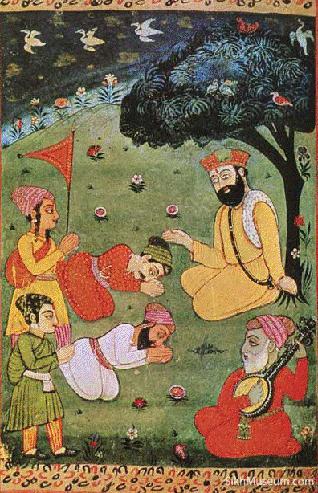 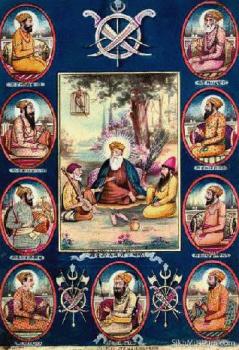 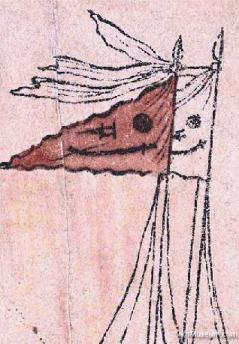 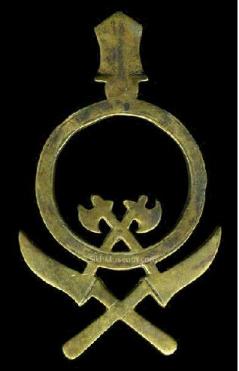 |
| Visit the Nishan Sahib exhibit at SikhMuseum.com. [The author is the curator of SikhMuseum.com and the creator of the world’s first Sikh website, sikhs.org] Images: Above top - A flag depicted in an illustrated manuscript (B40), 1733. Below, 1st from bottom - late 19th-century military turban badge. 2nd - 19th-C woodcut shows Akal Takht's Miri-Piri flags. 3rd - late 19C print of Gurus shows a version of khanda. |
------------------------------
Related Article:
http://www.sikhnet.com/inspiration/history-our-nishan-sahib
Further reading:
http://saty.co.uk/sikh-history/nishan_sahib.htm
------------------------------
Significance : Nishan Sahib
Weapons have traditionally played an important role in Sikh religious practice and Sikh history. An arrangement of weapons is found on todays modern Nishan Sahib as well as Nishan Sahibs of the past.
Learn about the various types of weapons that have appeared on Nishan Sahibs and why they are such an integral part of Sikh worship. Read a section of Guru Gobind Singhs Shaster Nam Mala in praise of God using various weapons as metaphors.

Actual proportions and scale of the weapons comprising the Sikh Khanda emblem.
Spiritual Significance
Why would the religious emblem of the Sikhs be composed of weapons?
An early travel account by a European explorer written a little over 80 years after the time of Guru Gobind Singh reveals the uniqe respect for their weapons have Sikhs have historically held:
It is said that they have a sort of superstitious respect for their sword. It was by it they obtained their independence and power; and by it they preserve them. A Seik, though in other respects infinitely less scrupulous than any other Hindoo, before he will eat with any one of another religion, draws his sword, and passing it over the victuals, repeats some words of prayer, after which he will freely partake of them. Sketches Chiefly Relating to the History, Religion, Learning, and Manners of the Hindoos Quintin Craufurd, 1790
Weapons, especially the sword have a deep spiritual meaning within Sikhism. The kirpan is one of the articles of faith that every baptized Sikh Khalsa is required to carry at all times. While the spiritual significance of each specific weapon appearing on a Nishan Sahib is open to subjective personal interpretation, a clearly defined spiritual association between weapons and the Supreme Being was established early on in the development of the religion by the Sikh Gurus.
In the first lines of the Sikh daily prayer Ardas, Guru Gobind Singh asks Sikhs to remember the Supreme Being and all the Gurus. In referring to God, the Guru chose to use the unique metaphor of the sword (Bhagauti):

Ekh-oonkaar Vaaheguroo jee kee Fat'eh.
Sree Bhagautee jee Sahaa-e.
Vaar Sree Bhagautee jee kee Paat'shaahee D'assveen
God is One. All victory is of the Wondrous Guru (God).
May the respected sword (God) help us!
Ode of the respected sword recited by the Tenth Guru.

Pritham Bhagat'ee simar kaae Guroo Nanak laeen’ D'hiaa-ae.
Phir Angad. Guroo t'ae Amar-Daas Ram-Daas-aae hoeen’ sahaa-ae.
First remember the sword (God); then remember and meditate upon Guru Nanak.
Then remember and meditate upon Guru Angad, Guru Amar Das and Guru Ram Das: May they help us!
The word Bhagauti, meaning sword, has been mis-interpreted by some to suggest that it is a reference to a Hindu diety with a similar sounding name and that these lines are evidence that Sikhs are worshippers of this Hindu diety. This is not the case as the Sikh context of the word has an altogether different meaning. The following lines from the poetry of Bhai Gurdas, the original scribe of the Guru Granth Sahib help to clarify the Sikh definition of Bhagauti as a metal sword:
Bhai Gurdas, Varan XXV, 6![]()
Nau bhagauti lohu gharaia
Iron (a lowly metal) when properly wrought becomes a (powerful) sword.
Source: http://www.sikhmuseum.com/nishan/weapons/index.html
